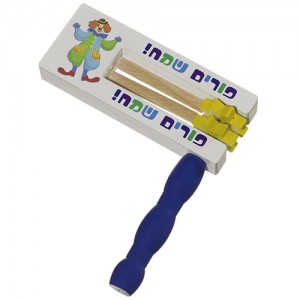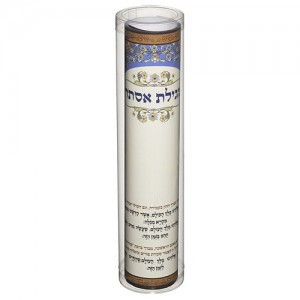Every year in the month of Adar we celebrate Purim, Hebrew for “lots.” This holiday, for many, is the most dramatic yet enjoyable holiday on the Jewish calendar. Spurred by yet another failed attempt at annihilating the Jews, Purim allows us to dress up in crazy costumes, eat Hamentashen galore and drink a lot of alcohol. Some of Purim’s commandments include mishloach manot, which is the exchange Purim gift baskets, matanot l’evyonim, giving gifts to the poor, reading Megillat Ester, scroll or Book of Esther, and, as Jews are wont to do, enjoying a festive meal. When we celebrate Purim, we rejoice not only at the fact that it is finally time to buy or make Purim costumes, or that we can get drunk in public without looking suspicious. More importantly, we praise God for thwarting those who wish to destroy us and for constantly listening to our prayers.
Purim
Every year in the month of Adar we celebrate Purim, Hebrew for “lots.” This holiday, for many, is the most dramatic yet enjoyable holiday on the Jewish calendar. Spurred by yet another failed attempt at annihilating the Jews, Purim allows us to dress up in crazy costumes, eat Hamentashen galore and drink a lot of alcohol. Some of Purim’s commandments include mishloach manot, which is the exchange Purim gift baskets, matanot l’evyonim, giving gifts to the poor, reading Megillat Ester, scroll or Book of Esther, and, as Jews are wont to do, enjoying a festive meal. When we celebrate Purim, we rejoice not only at the fact that it is finally time to buy or make Purim costumes, or that we can get drunk in public without looking suspicious. More importantly, we praise God for thwarting those who wish to destroy us and for constantly listening to our prayers.
Listening to Megillat Esther is Purim’s main commandment. If you attend synagogue on Purim, you will noticed that many of those in attendance bring an actual scroll from which to read, rather than reading from a standard printed version.When you buy a scroll, look into the different types of writing, such as Beit Yosef, which is the Ashkenzi version, the Chassidic/Sfard Ari Zal, and the Sefardic Vellish. Some megillahs today include commentaries, related stories and anecdotes and more. Do not worry about size; there are miniature as well as very large scrolls, all you have to do is pick. Remember, the price of the scroll will depend greatly on its size and material.
If you do choose to buy an megillah, or a scroll, be aware that you can also purchase a megillah case; this will not only keep the scroll in tact, but also be your way of showing reverence to this holy script. You have a number of options for a megillah case, including round wood megillah case, leather and Mahogany, Sterling silver megillah case, and more.
During the reading of the megillah, as you probably noticed, kids, and some adults, sound the grogger every time evil Haman’s name is mentioned. You might think that buying a grogger is the easiest thing in the world, but in reality there are various types of groggers, from plain plastic to ornate metal. When you buy a grogger think about who is going to use it, a toddler or a thirteen-year-old; is it only going to be used on Purim and then probably cast aside until next year, or would you also like to use it as a home-accessory during the year? Answer said questions and then you are ready to buy a grogger.
The giving of Purim gift baskets, which is not only mandated upon every Jew but also a great way to bond with loved ones, must include food. However, although law-wise food is an indispensable part of the Purim gift basket, we can add anything we want in addition. Think about who is going to receive it and what they like; for example, if you are going to give the Purim gift basket to your sister who loves chocolate, fill the basket with her favorite chocolate bars. If your friend or cousin like to read, you can buy them a book and add to a basket that will include basic foods, like fruit and Hamentashen . Of course, Judaica jewelry and Judaica art are always popular and appropriate Purim gifts.
Purim Guide
The holiday of Purim is one of joy and merriment. It is characterized by singing and dancing, dressing in costume, funny plays and performances (called “Purim shpiels”), and maybe even drinking a bit more than usual . . . What is the reason for all this mirth and festivity? The escape from a close call! The story of Purim is one in which the Jews were saved from almost certain destruction at the hands of a powerful and evil man. But with the help of G-d and a brave, young woman named Esther, in the end the tables were turned.
The Story of Purim
The Biblical Book of Esther has all the elements of a good tale: an evil villain, a brave hero, a beautiful heroine, plotting, spying, murder, intrigue. It tells the story of the Jews in the ancient kingdom of Persia, under the rule of a king named Ahashueus (in Hebrew “Achashveirosh”). After a series of events, the king finds himself married to a beautiful, young Jewish woman named Esther (though he has no idea she is a Jew). Concurrently, the king’s chief adviser, an evil man named Haman, has decided to kill all the Jews in the kingdom because they refuse to bow before him. Queen Esther’s cousin, Mordechai, convinces her (at great peril to herself) to approach the king, reveal her identity as a Jew, and ask him to stop the evil Haman’s plot. The story unfolds, the Jews are saved, Haman gets what’s coming to him, and let the party begin!
Megillah Reading
The primary observance of the holiday of Purim involves the public reading of the Book of Esther, which is usually contained in a scroll called the “Megillah” or “Megillat Esther.” In some ways similar to a Torah scroll, it is written in Hebrew calligraphy on parchment and is treated with great respect. But different from a Torah scroll, Megillat Esther is generally attached to only one roller (instead of the Torah’s two). Also different is that while Torah scrolls are usually only kept in the synagogue, oftentimes individuals choose to purchase their own Megillat Esther. Often the centerpiece of a Judaica collection, it is particularly important to keep a Megillah protected and covered (especially since it is only read once each year). A variety of different types of Megillah Cases can be used for this purpose--ranging from simple embroidered bags made of cloth or velvet to ornate sterling silver cases engraved with Hebrew and Jewish symbols.
On the evening of Purim, the Megillah is read in synagogue, but unlike most synagogue services, it is not a quiet affair! Each time the name of Haman is mentioned (54 times in the entire Book of Esther), it is customary to drown it out with noise so it cannot be heard. People shout, stamp their feet, and even play musical instruments! But the most traditional way to drown out the name of Haman is with a special noisemaker called (in Yiddush) a “Gragger” or (in Hebrew) “Ra-ashan.” Graggers can be made of metal, wood, even plastic . . . but the most important thing about them is that they make lots of noise!
Purim Foods
Another wonderful tradition associated with Purim is sending gifts of food to friends and family. These gifts usually include everyone’s favorite Purim treat--Hamantaschen (or “Oznei Haman” in Hebrew). Some say this triangular, filled cookie looks like Haman’s hat, some say his pockets, and some say his ears . . . but whatever they look like, they sure are delicious! Chag Purim Sameiach! Happy Purim!
For More Information
For more information about Purim or other Jewish holiday Judaica items, feel free to contact our Judaica experts with any questions or concerns.




